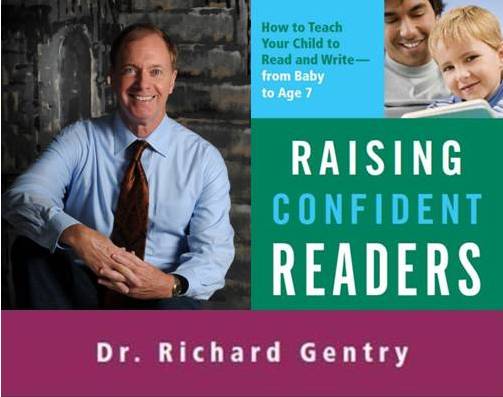What happens in Phase 1, age 3 to 5
In a previous post, dated Wednesday, April 21, 2010, we addressed the question of whether all children learn to read the same way by illustrating the different phases of reading and writing.
The answer to the question was "Yes!", and we discussed Phase 0, birth to age 3. To continue the discussion we now are ready to address:
What happens in Phase 1, age 3 to 5?
Your toddler learns to write her name and to read some words. She pretends to write messages and stories using random letters and attempts to imitate your reading of favorite books. Children should at minimum be in Phase 1 when they enter kindergarten to be ready for formal instruction in reading. Unfortunately, one and a half million American children come to kindergarten every year in Phase 0 unable to write their own name and not prepared for success with literacy.
Phase 1, Climbing the Phases of Beginning Reading, http://jrichardgentry.com/teachers.php
The following is an excerpt from my new book to be released in July, Raising Confident Readers: How to Teach Your Child to Read and Write—from Baby to Age 7:
“In Phase 1, your child’s naive and relatively unsophisticated strategies for writing may parallel what happens when she tries to read words in this phase. Since she doesn’t know that letters represent sounds, she’s not “sounding out” words, rather she’s likely relying on pictures or guessing. She may not be able to match your voice with the correct word when you read aloud unless you point to it. She’s “reading” a word like McDonalds as a visual logo by cueing on the golden arches—not the letters—and she may misread Crest as “toothpaste.
All of this being said, your little Phase 1 genius will shock you with what she can do: She may recognize familiar print in the environment, and she can memorize names, signs, labels, short easily memorized nursery rhymes, poems, verses, and songs with repetition and use memory reading to read them back. You will celebrate her “kid writing” and start an adult underwriting technique introduced in this chapter by occasionally providing the conventional form of the labels, phrases, lists, short directions that she produces as a pen and paper kid so that she can memorize it and read it back to you from conventional English. It’s a great time for memorizing favorite caption books, easy pattern books, pop-up books, board books, and concept books about animals, colors, flowers, or whatever she’s interested in. Remember, her favorites may not be yours. If she delights in what seems to you to be a silly unliterary little book with a finger puppet that’s what the two of you should be reading. When you can say “This is a book she really enjoys,” you have made the right choice for Phase 1.” Gentry, Raising Confident Readers: How to Teach Your Child to Read and Write—from Baby to Age 7 (New York, Da Capo Press, 2010), 119In our next blog posting, we will explore what happens in Phase 2, age 3 to 6.
RCR has gone to press!
I was informed last week that Raising Confident Readers had gone to press. It has been over two years of research, travel, working with parents and their children, rewrites, editing, deadlines, and all the many detailed things that are involved in writing a book, but it has been worth the time and some sleepless nights. In little over a 8 weeks, RCR will be in bookstores and available online. Pre-order RCR on Amazon.com and be one of the first to send me your comments and questions. Here is the link at amazon for RCR: http://tinyurl.com/23qbdfa
Advance Praise for Raising Confident Readers.
This important book will have profound impact on how parents of young children view their role as their child’s first and most important teachers. Now parents can gain access to the tools and habits of thought that classroom teachers routinely use to develop lifelong, life-wide, confident readers. Dr. Gentry’s easy to read, practical guidance is offered as a bridge between experts in the field of reading instruction, brain science and parents trying to do the best they can to raise children who can and love to read and write. Imagine what could happen if this were required reading for all new parents and people who have children in their lives! Parents who read this book will become confident in their role of raising confident readers.—Antoinette Fornshell, author of Planning for Successful Reading and Writing Instruction in K-2
I owe a debt of gratitude to Antoinette Fornshell, with whom I shared some of the first stages of the RCR project. Her early positive feedback was inspirational, especially when things were getting off to a slow start. So thank you Antoinette, for all your encouragement and advise.
Timeout
 After a very busy Spring and what looks to be a very busy Summer with book promotions, meetings, consulting and a couple of new writing projects, I took a week off to chill on my beach here in Fort Lauderdale and spend some down time in South Beach. I have done a little water color painting, read a little, had some wonderful dinners with friends. I hope each of you are able to enjoy some down time to reenergize and move forward.
After a very busy Spring and what looks to be a very busy Summer with book promotions, meetings, consulting and a couple of new writing projects, I took a week off to chill on my beach here in Fort Lauderdale and spend some down time in South Beach. I have done a little water color painting, read a little, had some wonderful dinners with friends. I hope each of you are able to enjoy some down time to reenergize and move forward. 



No comments:
Post a Comment